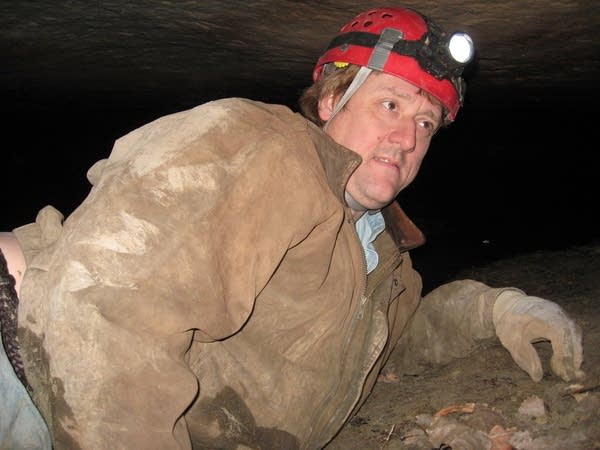Geologist shines light on Twin Cities caves

Greg Brick's friends call his car "the traveling circus." His trunk is full of spelunking gear, including what he calls his "Frankenstein sewer boots."
All his caving clothes are caked with dirt -- a flour-fine powder from the eroded sandstone at Dayton's Bluff in St. Paul.
His jacket is so filthy that he's not allowed to bring it in the house, let alone put it in the washing machine. He just gives it a few stiff whacks with a plastic baseball bat to beat the dust off, before he embarks on an expedition.
Carver's cave is one of the few places covered in "Subterranean Twin Cities" that is safe and legal for the public to visit.
Create a More Connected Minnesota
MPR News is your trusted resource for the news you need. With your support, MPR News brings accessible, courageous journalism and authentic conversation to everyone - free of paywalls and barriers. Your gift makes a difference.
It's not a big cave. There are only two feet between floor and ceiling as you crawl inside. And you can't crawl far before you hit the water. Most of the cave is taken up by an underground lake.
"When I've gone out there before in a wet suit, I can't even touch the bottom with my feet," Brick said. "That's how deep the water is."
The water hewed the cave in the wall of a sandstone bluff. Brick says all the caves in the Twin Cities are sandstone, as opposed to the ones in southeastern Minnesota, which are made of limestone.
Brick calls Carver's Cave "the most historic cave in Minnesota." It was sacred to the Dakota Indians long before British explorer Jonathan Carver threw a pebble in the cave lake in 1766.
"I could hear that it fell into the water," Carver later wrote, "and notwithstanding it was of so small a size, it caused an astonishing and horrible noise that reverberated through all those gloomy regions."
Attempting recreate Carver's experiment on a recent morning, the pebble produced more of a plop than a horrible noise. But these gloomy regions can be scary, even for an experienced speliologist like Brick.
"I came into this cave one night and I heard a splash in the back end, and I just thought it was a rock falling," he recalled. "But then I heard another splash shortly after that, and I thought, 'there is somebody in the cave with me.'"
Then, he heard another splash.
"And I realized there was an angry beaver about a dozen feet away from me and he was slapping his tail on the surface of the water," Brick said.
A beaver was not nearly as scary as an unexpected human would have been.
Brick says mystery certainly draws people to explore the underground, but that's only one attraction.
"I know the motivation for a great number of people is a place to consume alcoholic beverages on a hot summer evening," he deadpanned. "The caves are nice and cool."
During the great depression homeless men lived in Carver's Cave. There are even accounts that say they built cabins there. Brick points out the water level in the lake must have been much lower than it is today to make room for such a structure.
"The cave as a whole -- no pun intended -- goes back just over a hundred feet," he said. "It's a very short cave with a very long history."
